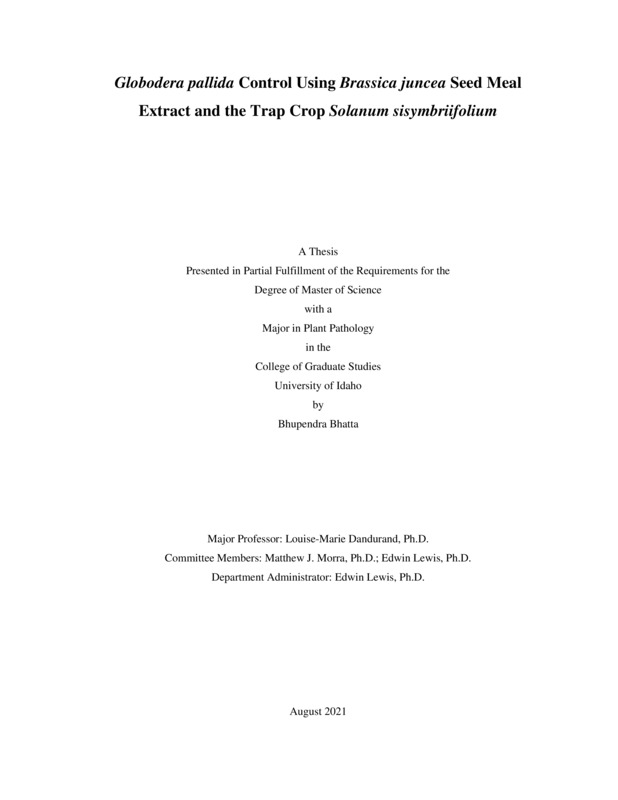Globodera pallida Control Using Brassica juncea Seed Meal Extract and the Trap Crop Solanum sisymbriifolium
Bhatta, Bhupendra. (2021-08). Globodera pallida Control Using Brassica juncea Seed Meal Extract and the Trap Crop Solanum sisymbriifolium. Theses and Dissertations Collection, University of Idaho Library Digital Collections. https://www.lib.uidaho.edu/digital/etd/items/bhatta_idaho_0089n_12164.html
- Title:
- Globodera pallida Control Using Brassica juncea Seed Meal Extract and the Trap Crop Solanum sisymbriifolium
- Author:
- Bhatta, Bhupendra
- Date:
- 2021-08
- Keywords:
- Biofumigant Brassica juncea Globodera pallida Integrated pest management Solanum sisymbriifolium Trap crop
- Program:
- Plant, Soil and Entomological Sciences
- Subject Category:
- Plant pathology
- Abstract:
-
Globodera pallida, the pale cyst nematode, is a regulated potato pest with the potential for detrimental economic impacts. Restrictions on use of the soil fumigant, methyl bromide, and lack of resistant russet type varieties for US markets have led to investigations of alternative strategies to control this potato pest. The efficacy of Brassica juncea seed meal extract (SME) was evaluated under greenhouse conditions (0, 0.14, 0.28, 0.56, 1.12, and 2.24 t SME/ha) and field conditions (0, 1.12, and 2.24 t SME/ha in year 2019 and 0, 0.14, 0.28, 0.56, and 1.12 t SME/ha in year 2020) either applied alone or in combination with the trap crop Solanum sisymbriifolium. The impact of the application of SME pre- or post-planting S. sisymbriifolium was determined. Solanum sisymbriifolium alone reduced the number of encysted eggs compared to the untreated control by up to 60% in greenhouse and 67% in field trials. When SME was applied post-planting, S. sisymbriifolium induced hatch of G. pallida and significantly fewer encysted eggs remained at termination of the experiment whether or not SME was applied. When SME was applied pre-plant, the remaining encysted eggs were not decreased by planting S. sisymbriifolium which may indicate that SME inhibited egg hatch in the presence of S. sisymbriifolium. Treatments with SME either alone or with S. sisymbriifolium provided a significant reduction of G. pallida egg viability, hatch, and reproduction compared to the untreated control at all rates tested under greenhouse conditions. Combined treatment with S. sisymbriifolium and SME at lower rates, 0.14 t/ha for pre-plant or 0.56 t/ha or less for the post-plant experiment, further reduced egg hatch and reproduction than each treatment alone. SME alone applied at higher rates of 1.12 and 2.24 t/ha whether or not combined with S. sisymbriifolium eliminated G. pallida reproduction on potato in both pre-plant and one post-plant greenhouse trials. In the second post-plant greenhouse trial, SME at 1.12 t/ha and 2.24 t/ha when applied alone highly reduced the reproduction factor compared to the untreated control by 64 and 89%, respectively, and eliminated reproduction when used in combination with S. sisymbriifolium. Collectively, our results indicated that a combination of SME and S. sisymbriifolium allows an opportunity to reduce the amount of SME required to control G. pallida and further decrease the potential reserve of the viable population remaining after individual treatment with each strategy.
- Description:
- masters, M.S., Plant, Soil and Entomological Sciences -- University of Idaho - College of Graduate Studies, 2021-08
- Major Professor:
- Dandurand, Louise-Marie
- Committee:
- Morra, Matthew J.; Lewis, Edwin
- Defense Date:
- 2021-08
- Identifier:
- Bhatta_idaho_0089N_12164
- Type:
- Text
- Format Original:
- Format:
- application/pdf
- Rights:
- In Copyright - Educational Use Permitted. For more information, please contact University of Idaho Library Special Collections and Archives Department at libspec@uidaho.edu.
- Standardized Rights:
- http://rightsstatements.org/vocab/InC-EDU/1.0/

